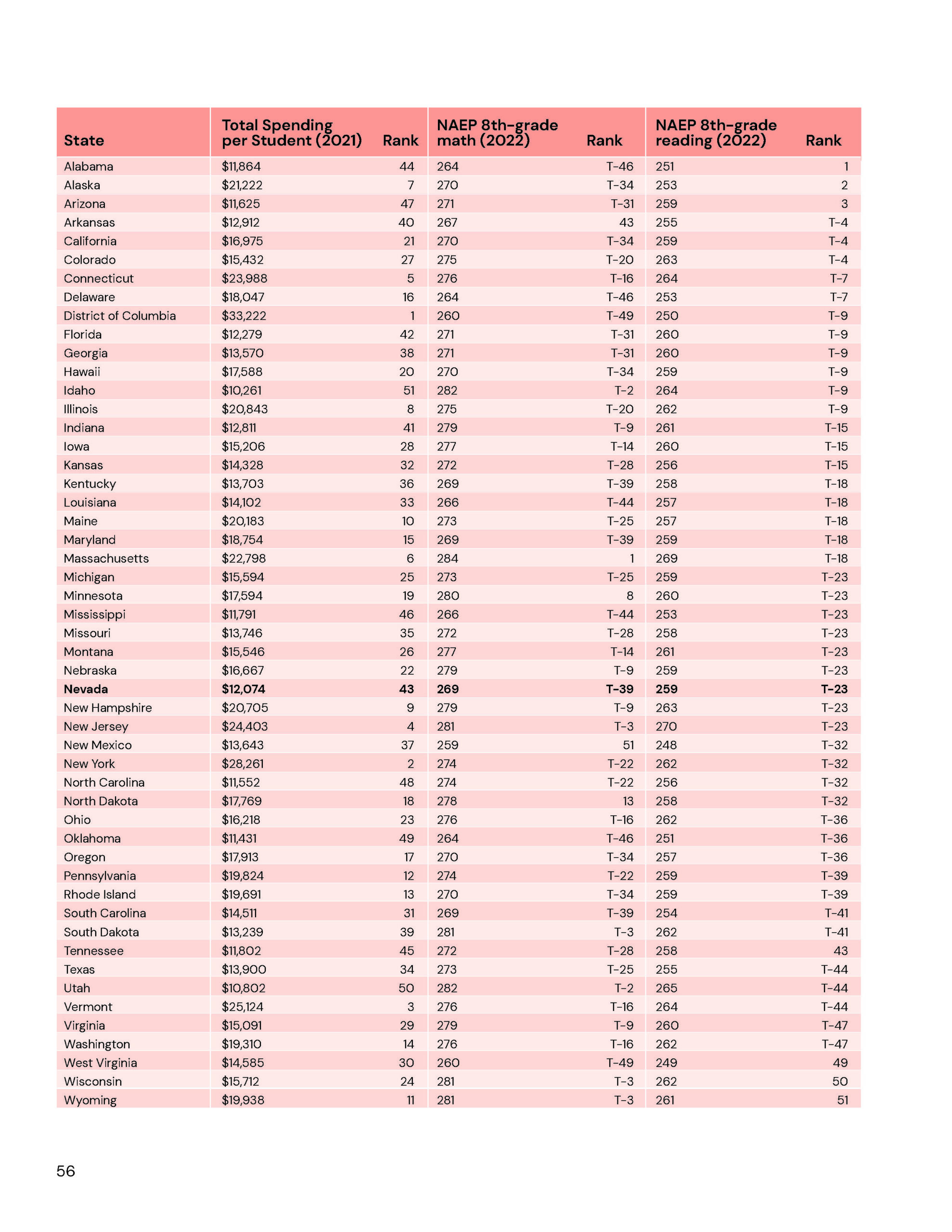Education Spending vs. Student Performance
Lawmakers often hear that the only way to boost educational performance is through massive increases in K-12 spending. It may seem intuitive that a greater input of funding should yield a superior educational output, or that lawmakers can “purchase” better educational results by simply allocating more money. However, public school districts have historically struggled to translate increased funding into improved student performance.
This unfortunate result occurs because public school districts – constantly subject to the political influence of entrenched interest groups – regularly fail to allocate resources cost-effectively.
Key Points
Nevada has more than doubled per-pupil funding, on an inflation-adjusted basis, while educational quality has deteriorated. The U.S. Department of Education reports that, between FY1970 and FY2021, real, per-pupil funding for “current expenditures” (not accounting for employee benefits, capital outlays and debt repayment) increased from $6,104 to $12,465.1 Over the same time period, Nevada’s performance on college admission exams, which measure students’ ability to complete college-level coursework, have continually deteriorated.2
A majority of states that spend less than Nevada boast higher test scores. According to the U.S. Department of Education, Alabama, Arizona, Idaho, Mississippi, North Carolina, Oklahoma, Tennessee and Utah all spent less per pupil in FY21 than did Nevada. Half of those states outperformed Nevada on the NAEP 8th grade reading test and a majority outperformed Nevada in math.3
Nevada is a high spender for its neighborhood, but a low performer. Among Nevada’s five contiguous neighbors, only California and Oregon spend more per pupil. However, of the five, only Oregon underperforms Nevada in student achievement.4
Student achievement is correlated with genuine education reform. Much more than per-pupil spending levels, specific education reforms have been shown to lead directly to greater student achievement. These reforms include school-choice programs, alternative teacher certification, teacher evaluations based upon student performance, leveraging technology and maintaining strict academic standards.5
Recommendations
Current per-pupil spending levels are appropriate to the region. Nevadans already spend more per pupil than a majority of their regional neighbors. Yet, children in Nevada outscore only those of Oregon – a regionally high-spending state. Nevada’s educational challenges appear to be mainly structural.
Restore and expound on reforms enacted in 2011 and 2015. In 2011, lawmakers agreed to legislation creating an alternative teacher certification program, a statewide charter school authority and a meaningful evaluation system for teachers. In 2015, lawmakers also created an Achievement School District, ended the practice of social promotion and tried to create school choice.
In 2017 and 2019, lawmakers began walking back these changes. They decided not to evaluate teachers based on student performance,6 weakened alternative teacher certification laws,7 and repealed language authorizing education savings accounts.8 Those incipient reforms have experienced great success in other states but were never given the chance to succeed in Nevada.
There are at least 33 ways to improve student performance without spending more. Nevada Policy has developed a comprehensive framework for school reform including 33 major components that should guide future legislative efforts.9

1 U.S. Department of Education, National Center for Education Statistics, Digest of Education Statistics, 2023
2 Ibid.
3 Ibid.
4 Ibid.
5 Matthew Ladner, Ph.D. et al., “Report Card on American Education: Ranking State K-12 Performance, Progress and Reform, 16th Edition,” American Legislative Exchange Council, 2010.
6 Nevada Legislature, 79th Session, Assembly Bill 320.
7 See “Alternative Teacher Certification.”
8 Nevada Legislature, 80th Session, Senate Bill 551.
9 Geoffrey Lawrence, “33 Ways to Increase Student Achievement without Spending More,” Nevada Policy Research Institute policy study, July 2014.
